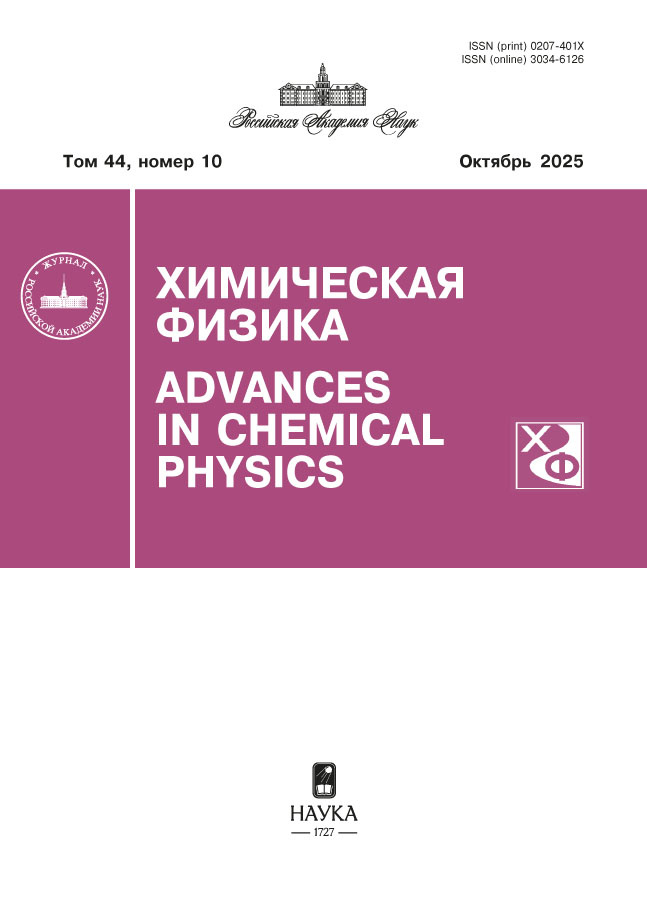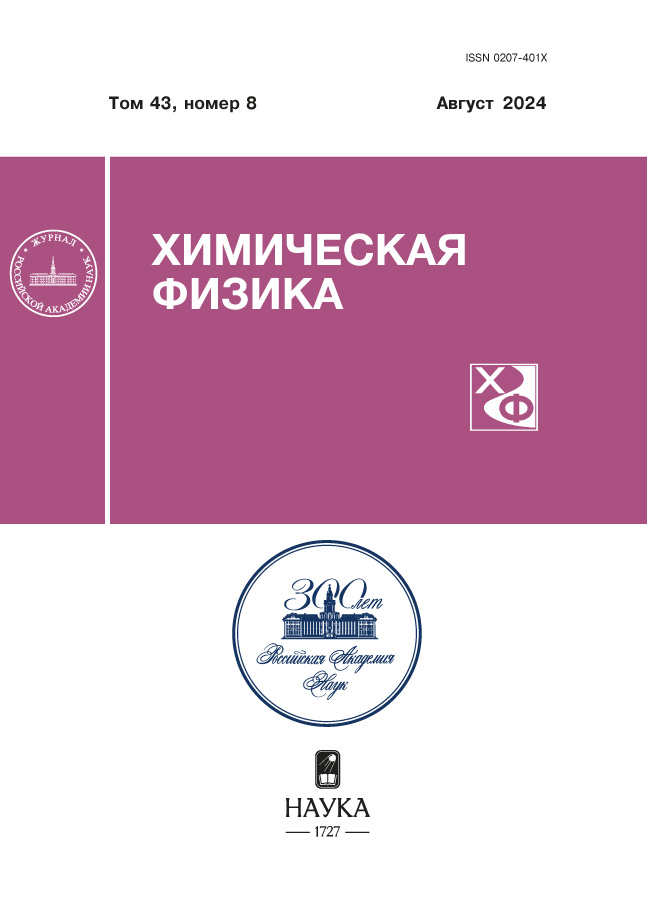Том 43, № 8 (2024)
Кинетика и механизм химических реакций, катализ
Кинетика термического разложения полиметилметакрилата в среде углекислого газа
Аннотация
Методом термогравиметрического анализа определены кинетические константы термического разложения полиметилметакрилата в потоке углекислого газа в широком диапазоне скоростей нагрева образцов (2–50 К/мин). Значения кинетических констант разложения определены по методу постоянных степеней превращения. Показано, что для степеней превращения вещества от 10 до 90% значения энергии активации термораспада ПММА изменяются в диапазоне 213.5–194.3 кДж/моль, а значения предэкспоненциального коэффициента – в диапазоне 1.62 · 1016– 6.85 · 1012 с−1. Среднее значение энергии активации термораспада ПММА в потоке углекислого газа составило 206 кДж/моль.
 3-9
3-9


Горение, взрыв и ударные волны
Особенности ингибирования водородно-воздушных смесей добавкой пропилена
Аннотация
Небольшие добавки углеводородов, таких как пропилен, широко исследуемые в качестве ингибиторов горения и взрыва водородно-воздушных смесей, иногда проявляют весьма специфические свойства. Известен механизм ингибирующего действия этих добавок, связанный с интенсификацией обрыва цепей разветвления за счет присоединения атомов водорода; но также известны условия, в которых эти соединения вместо ингибирования оказывают нейтральное и даже промотирующее действие. Такие условия, как и причины, приводящие к тому, что ингибирование практически отсутствует, до сих пор не исследовались. В данной статье рассмотрены результаты численного моделирования, которые позволяют более полно очертить область условий, в которых добавка пропилена практически не ингибирует водородновоздушные смеси, и наметить возможные причины этого эффекта. Представлено решение трех модельных задач: самовоспламенение в реакторе постоянного объема, распространение ламинарного пламени и зажигание газа нагретой проволокой. Расчеты проводились с использованием детального кинетического механизма химических реакций NUIGMech 1.1 (2020). Объектами исследования были три воздушные смеси, содержащие водород в количестве 15, 29.6 и 50 об.% (бедная, стехиометрическая и богатая смесь соответственно) без добавок и с добавкой 1% пропилена.
 10-23
10-23


Особенности горения в системе 2Co–Ti–Al и свойства полуметаллического ферромагнитного сплава Гейслера Co2TiAl
Аннотация
Методом высокоскоростной видеосъемки исследовано горение в системе 2Co–Ti–Al. Установлено, что горение происходит во фронтальном режиме. Определены параметры процесса. Максимальная скорость роста температуры горения с момента инициирования до максимального значения достигала 2.7 · 104 К/с. Рассчитанная по видеозаписи скорость распространения фронта составила 9.4 см/с. Обнаружен микроочаговый режим горения реакционного состава. Исследованы температурные зависимости удельного электросопротивления и магнитного момента синтезированного в режиме горения однофазного продукта Co2TiAl. Для синтезированного образца Co2TiAl значение температуры Кюри составляет Tс = (120 ± 5) К, а удельное электросопротивление при комнатной температуре – 1.35 мкОм ⋅ м. Показано, что электрические и магнитные свойства сплава Co2TiAl, полученного в режиме горения, аналогичны свойствам сплавов, полученных методом дуговой плавки.
 24-30
24-30


Влияние механической активации и примесного газовыделения на макрокинетику горения и структуру продуктов в системе Ti–C–B для прессованных компактов и гранулированных смесей
Аннотация
Проведено исследование влияния механической активации системы 100 −x(Ti+C)+x(Ti+2B) на закономерности горения образцов с различной макроструктурой: прессованных компактов с относительной плотностью 0.53–0.6 и гранул насыпной плотности размером 0.6–1.6 мм. Установлено, что механическая активация порошков приводит к постепенному снижению скорости горения прессованных образцов по мере увеличения содержания Ti+2B в смесях – нисходящая зависимость, в то время как увеличение содержание Ti+2B в компактах из неактивированных порошков приводит к увеличению скорости горения – восходящая зависимость. Полученные результаты противоречат теоретическим представлениям о влиянии механической активации на процесс горения, в соответствии с которыми скорость горения должна возрастать. Одним из важных факторов, влияющих на изменение скоростей горения, является примесное газовыделение. Впервые экспериментально определено влияние механической активации на закономерности горения гранулированных смесей. Установлено, что скорости горения гранулированных смесей выше, чем порошковых, для всех исследованных составов. Показано, что скорость горения гранулированных смесей из активированного порошка в среднем в 3 раза выше по сравнению с гранулами из неактивированного порошка. При этом зависимость скорости горения от массового содержания Ti+2B имеет локальный минимум, который, вероятно, связан с особенностями процесса механической активации.
 31-41
31-41


Экспериментальное исследование воспламенения стехиометрической смеси пропилен–кислород–аргон за отраженной ударной волной
Аннотация
Проведено исследование самовоспламенения стехиометрической смеси пропилен–кислород–аргон с объемным содержанием аргона 95%. Эксперименты выполнены на ударной трубе, входящей в состав экспериментального комплекса “Ударная труба” НИИ механики МГУ, в режиме за отраженной ударной волной. Проанализированы временны́е зависимости сигналов от пьезоэлектрического датчика давления, термоэлектрического детектора и оптической секции, настроенной на регистрацию излучения электронно-возбужденных радикалов OH• (l = 302 нм), CH• (l = 427 нм) и молекулярного углерода C2• (l = 553 нм). Измерены времена задержки воспламенения, τign, в диапазоне температур T = 1200–2460 K и давлений p = 4.5–25 атм. Полученные данные сравниваются с результатами других авторов.
 42-48
42-48


Численное моделирование окислительной конверсии метана в синтез-газ в реакторе с обращаемым потоком
Аннотация
Проведено численное моделирование окислительно-паровой конверсии метана в синтез-газ в реакторе фильтрационного горения без предварительного смешения реагентов с обращаемым потоком метанопаровой смеси и непрерывной подачей кислорода в центр реактора. Расчет проведен для мольных отношений кислород/метан 0.47 и пар/метан 0.5 в параметрической области, близкой к пределу реализации схемы. Рассмотрены различные режимы инициирования и управления обращением потока, получены количественные и качественные зависимости температуры горения и состава продуктов реакции от характеристик процесса. Сравнение параметров установившегося циклического режима конверсии с предсказанными по равновесной модели показывает, что кинетические ограничения приводят к более высокой температуре горения и неполному превращению метана. При высокой температуре конверсия протекает с образованием сажи и последующей реакцией ее с водяным паром.
 49-61
49-61


Метательная способность смесей взрывчатых веществ с положительным и отрицательным кислородным балансом
Аннотация
Проанализированы возможности повышения метательной способности (МС) энергетических материалов за счет создания смесей взрывчатых веществ (ВВ), обладающих положительным и отрицательным кислородным балансом. Для расчетов в качестве ВВ-окислителей были выбраны относительно новые соединения: 3,6-динитро-1,4-бис(тринитрометил)-1,4-дигидропиразоло[4,3-с]пиразол; 4,4′5,5′-тетранитро-2,2′-бис(тринитрометил)-2Н,2′Н-3,3′-бипиразол; 2-динитрометил-5-нитротетразол. Функцию ВВ-горючего выполняли вещества октоген и CL-20. Из расчетов следует, что МС октогена заметно возрастет при добавлении к нему указанных окислителей, а введение окислителей в состав с веществом CL-20 приведет лишь к незначительному повышению МС.
 62-69
62-69


Термодинамическая оценка режимов получения водорода при пиролизе аммиака в реакторе фильтрационного горения с подвижным слоем теплоносителя
Аннотация
Предложено использовать процесс пиролиза аммиака в реакторе фильтрационного горения с подвижным слоем теплоносителя с целью получения водорода. Процесс может быть реализован в реакторах с рекуперацией энергии при раздельной подаче реагентов (в том числе в реакторах типа Swiss Roll и др.). Рассчитан массово-энергетический баланс процесса. Анализ продуктов пиролиза проводился при условии термодинамического равновесия с варьированием температуры (300–1100 К) и давления (1–10 бар). Показано, что при атмосферном давлении пиролиз аммиака заканчивается до температуры 620 К. Повышение давления в системе приводило к небольшому увеличению температуры полного термического разложения аммиака. Доля сжигаемого водорода, необходимого для покрытия энергетических затрат на нагрев и пиролиз исходного аммиака в случае адиабатического реактора, составила 0.13. Из одного моля аммиака можно получить 1.31 моля водорода.
 70-77
70-77


Режимы горения водорода при прямой подаче его в камеру сгорания ДВС
Аннотация
Работа посвящена анализу процессов в камере сгорания двигателя с искровым зажиганием при прямой струйной подаче водорода на такте сжатия. Методами численного моделирования исследуются особенности перемешивания водорода с воздухом и его горения после воспламенения от искры в момент достижения поршнем верхней мертвой точки (ВМТ). Рассмотрены режимы горения при варьировании давления впрыска от 20 до 140 атм и времени начала впрыска от 180° до 45° поворота коленчатого вала (п.к.в.) до ВМТ. Во всех случаях при впрыске в камеру сгорания подается масса водорода, необходимая для образования стехиометрической смеси с воздухом. Получено, что наиболее однородная смесь на момент поджига образуется при ранней подаче (180°–135° п.к.в. до ВМТ) под относительно невысоким давлением (20–60 атм). Поджиг однородной смеси в рассматриваемых условиях приводит к детонационному режиму сгорания. Меньшая степень однородности смеси соответствует медленному, дефлаграционному, режиму горения. Важно отметить, что неоднородность смеси определяет неоднозначность формирования того или иного режима горения в зависимости от локального состава смеси в области искры. При этом наиболее медленный режим горения обеспечивает максимальное недогорание водорода: до 8.2%. В целом, рассмотренные диапазоны давления и времени начала подачи соответствуют удовлетворительным значениям недогорания водорода, не превышающим 4%.
 78-91
78-91


Возникновение послойного горения в смесях аммиачной селитры с алюминием и его переход в конвективное
Аннотация
Изучалось возникновение послойного горения и переход его в конвективное в смесях аммиачной селитры с алюминием насыпной плотности. Эксперименты проводились в манометрической бомбе с регистрацией давления. Пористость образцов составляла 0.55–0.59, размер частиц селитры 20–40 и 250–630 мкм, содержание алюминия изменялось от 8% до 47%. Использовался алюминий двух марок: сферический АСД-4 и чешуйчатый ПАП-2. Показано, что поджигание смесей происходит при давлении воспламенителя, близком к пороговому (минимальному) значению или выше него. Измерены величины порогового давления при различных размерах частиц аммиачной селитры, для разных марок и концентраций алюминия. Определены значения давления и времени, при которых возникают послойный и конвективный режимы горения. Показано, что замена алюминия АСД-4 на ПАП-2 приводит к существенному (на порядок и более) уменьшению порогового давления и давлений, при которых начинаются послойный и конвективный режимы горения.
 92-100
92-100


Влияние микрокапель воды на развитие неустойчивости фронта горения обедненной водородно-воздушной смеси в канале
Аннотация
В работе с использованием методов численного моделирования рассматривается процесс горения газовой смеси водорода с воздухом в канале с подачей свежей смеси с примесью микрокапель воды. Динамика микрокапель описывается в лагранжевом приближении, что позволяет выявить роль локального взаимодействия капель с поверхностью фронта пламени. Показано, что локальное воздействие капель на фронт пламени может провоцировать генерацию возмущений фронта и интенсифицировать развитие неустойчивости, тем самым обеспечивая интегральный рост скорости горения. С использованием спектрального анализа пространственной структуры фронта пламени в присутствии микрокапель проведен анализ динамики развития отдельных гармоник возмущений фронта и выявлены закономерности его эволюции при воздействии микрокапель воды.
 101-108
101-108


ФИЗИЧЕСКИЕ МЕТОДЫ ИССЛЕДОВАНИЯ ХИМИЧЕСКИХ РЕАКЦИЙ
Эффективность удержания ионов в комплексной плазме тлеющего разряда
Аннотация
Численно определены параметры плазмы тлеющего разряда низкого давления в неоне с микрочастицами, при которых реализуются области с равными значениями эффективности удержания ионов в облаке микрочастиц. Отмечено, что подобные особенности характерны для диссипативных синергетических систем, контролируемых обратной связью. Моделирование комплексной плазмы тлеющего разряда в неоне с микрочастицами показало, что обратная связь в плазме реализуется через источник основных потерь ее энергии – облако микрочастиц. Контроль за изменением параметров разряда путем варьирования концентрации микрочастиц в облаке дает возможность управлять концентрацией ионов в плазме.
 109-115
109-115


Статьи
Ошибки в статье: "Роль эффективности соударений с третьим телом в самовоспламенении водородно-воздушных смесей" (Химическая физика. 2024. Т. 43. № 7. С. 73–82; DOI: 10.31857/S0207401X24070071)
Аннотация
Замена редакцией заголовка на английском языке в метаданных на с. 81:
Вместо “COLLISION EFFICIENCY IN AUTOIGNITION OF HYDROGEN–AIR MIXTURES” должно быть “THE ROLE OF THIRD-BODY COLLISION EFFICIENCY IN AUTOIGNITION OF HYDROGEN–AIR MIXTURES”.
 116-116
116-116













